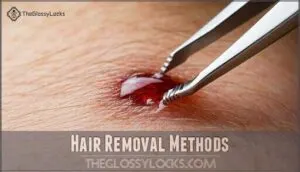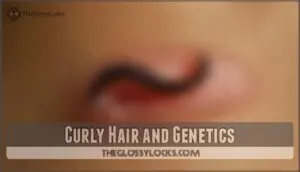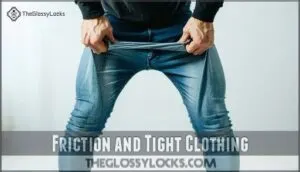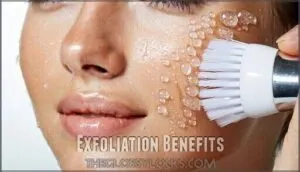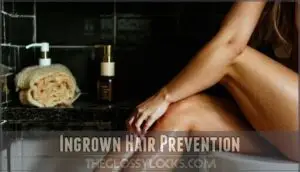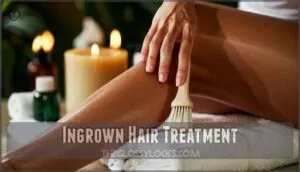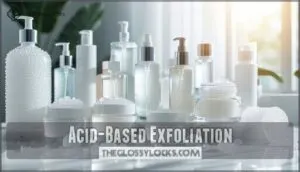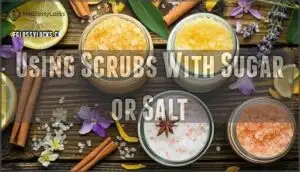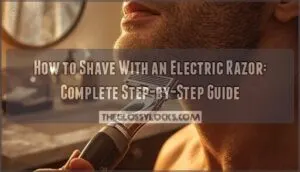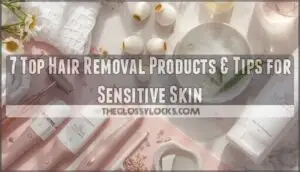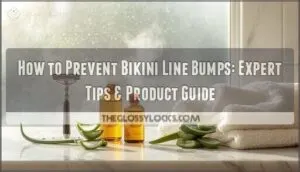This site is supported by our readers. We may earn a commission, at no cost to you, if you purchase through links.
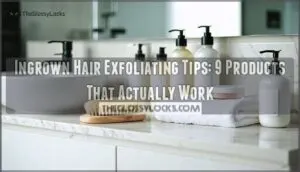 Dealing with ingrown hairs can feel like you’re trapped in a frustrating cycle, but the right ingrown hair exfoliating tips can set you free.
Dealing with ingrown hairs can feel like you’re trapped in a frustrating cycle, but the right ingrown hair exfoliating tips can set you free.
Gentle exfoliation removes dead skin cells that block hair follicles, allowing trapped hairs to break through the surface. Use a soft brush, washcloth, or mild scrub with warm water in circular motions 2-3 times weekly.
Avoid over-exfoliating, which irritates skin and worsens the problem. Chemical exfoliants containing salicylic acid or glycolic acid work particularly well for stubborn cases.
The key is consistency without aggression—your skin needs encouragement, not punishment. The most effective products combine multiple approaches for maximum results, using the right techniques for gentle exfoliation and effective products to achieve maximum results.
Table Of Contents
- Key Takeaways
- Ingrown Hair Causes
- Exfoliation Benefits
- Top 9 Exfoliating Products
- 1. ingrown hair eliminating wax pads
- 2. Natural Body Exfoliation Skin Brush
- 3. Natural Bristle Body Care Brush
- 4. Korean Exfoliating Mitt Bath Set
- 5. Dead Sea Salt Body Scrub
- 6. Keratosis Pilaris Body Scrub Exfoliator
- 7. CeraVe Daily Moisturizing Body Lotion
- 8. Hydrating Body Lotion For Dry Skin
- 9. Cortizone Maximum Strength Itch Cream
- Ingrown Hair Prevention
- Ingrown Hair Treatment
- Effective Exfoliation Methods
- Frequently Asked Questions (FAQs)
- What helps draw out an ingrown hair?
- How to draw out an ingrown hair cyst?
- Does hydrogen peroxide get rid of ingrown hairs?
- How often should you replace exfoliating tools?
- Can ingrown hairs cause permanent scarring?
- Which body areas need different exfoliation techniques?
- Are electric razors better for preventing ingrowns?
- When should you see a dermatologist?
- Conclusion
Key Takeaways
- You’ll prevent most ingrown hairs by exfoliating 2-3 times weekly with gentle circular motions—consistency beats intensity every time
- Chemical exfoliants containing salicylic or glycolic acid work better than harsh scrubs for dissolving dead skin cells that trap hairs beneath the surface
- Don’t over-exfoliate or you’ll irritate your skin and make ingrown hairs worse—your skin needs encouragement, not punishment
- Combine exfoliation with loose-fitting clothes and proper moisturizing to create the ideal environment for healthy hair growth and bump-free skin
Ingrown Hair Causes
Ingrown hairs develop when your hair grows back into the skin instead of rising above the surface, creating painful bumps and irritation.
Your hair becomes trapped beneath the skin, creating painful bumps that turn routine grooming into a frustrating battle.
This happens most often after shaving, waxing, or plucking because these methods can cause hair to curl back under the skin or leave sharp edges that pierce through, leading to irritation.
Hair Removal Methods
Your choice of hair removal technique directly impacts your risk of developing ingrown hairs.
Common methods like shaving, waxing, and threading disrupt natural hair growth patterns, creating sharp edges that can pierce skin during regrowth.
Consider these risk factors:
- Shaving against the grain increases hair’s likelihood of curving back into skin
- Multi-blade razors cut hair too close, causing retraction into follicles
- Waxing and plucking trigger inflammatory responses that worsen ingrown hair formation
Understanding the causes of ingrown hairs, such as hair follicle issues, can help individuals take preventive measures to reduce their occurrence.
Curly Hair and Genetics
Your genetics play a major role in ingrown hair development.
If you have curly hair, your follicles naturally curve, making it easier for hair to grow sideways into skin.
This genetic predisposition increases your risk substantially.
| Hair Texture | Follicle Shape | Ingrown Hair Risk |
|---|---|---|
| Straight hair | Linear follicles | Low risk |
| Wavy hair | Slightly curved | Moderate risk |
| Curly/coarse hair | Curved follicles | High risk |
Curly genetics create higher hair density and irregular growth patterns.
Your follicle care routine becomes essential when dealing with this genetic predisposition.
Understanding your hair texture helps you choose better ingrown hair removal methods and hair exfoliation tips customized to your specific needs.
Friction and Tight Clothing
Your clothing choices can become your skin’s worst enemy when fabric rubs against sensitive areas.
Tight clothing creates constant friction that pushes cut hair back into follicles, triggering inflammation and bumps.
Consider these friction hotspots:
- Waistbands – Elastic bands around your bikini line trap moisture and create persistent rubbing
- Undergarments – Snug bras and underwear press against freshly shaved underarms and groin areas
- Athletic wear – Compression shorts and fitted workout gear intensify skin irritation during movement
Fabric choice matters for ingrown hair prevention.
Breathable materials reduce skin irritation while loose-fitting garments allow proper air circulation.
Smart friction reduction starts with selecting clothes that don’t cling to recently treated skin areas.
Exfoliation Benefits
Regular exfoliation removes dead skin cells that block hair follicles, preventing hairs from becoming trapped beneath your skin’s surface.
This process also lifts existing ingrown hairs and creates a smoother pathway for new hair growth, reducing inflammation and those painful bumps you’re trying to avoid.
Preventing Ingrown Hairs
Exfoliation breaks the cycle of trapped hairs by removing dead skin cells that block follicles.
Regular skin exfoliation creates smooth pathways for hair growth, preventing razor bumps before they start.
Here’s how different exfoliating methods stack up for ingrown hair prevention:
| Method | Frequency | Best For |
|---|---|---|
| Chemical exfoliants | 2-3x weekly | Sensitive skin, follicle health |
| Physical scrubs | 1-2x weekly | Thick skin, immediate results |
| Dry brushing | Weekly | Overall skin care, circulation |
Smart exfoliant tips include timing treatments 2-3 days before hair removal and choosing gentler options for delicate areas.
This proactive approach to skin exfoliation addresses ingrown hair causes at their source, focusing on regular skin exfoliation and smooth pathways for hair growth, which helps in preventing razor bumps.
Unclogging Hair Follicles
Clogged follicles trap hairs beneath your skin’s surface, creating those frustrating bumps you’re trying to eliminate.
Dead skin buildup combines with oil and debris, forming keratin plugs that block normal hair emergence.
Here’s how proper exfoliating methods restore follicle health:
- Chemical exfoliants dissolve oil control issues without harsh scrubbing
- Physical scrubs remove surface debris when used gently
- Scalp massages stimulate circulation while dislodging buildup
- Clarifying treatments target deep-seated pore minimization needs.
Regular skin exfoliation prevents ingrown hair causes by keeping pathways clear. Addressing this issue can be done by using clarifying shampoos to deeply cleanse.
Promoting Healthy Hair Growth
Regular exfoliation creates an ideal environment for hair growth by keeping follicles clear and promoting follicle stimulation.
When you exfoliate skin consistently, you’re supporting scalp health and hair strength throughout the growth cycle.
This simple practice enhances nutrient intake at the cellular level, allowing hair follicle care to flourish.
Your ingrown hair treatment becomes more effective when combined with proven hair growth tips and ingrown hair remedies.
Top 9 Exfoliating Products
Choosing the right exfoliating products can make the difference between smooth, bump-free skin and persistent ingrown hair frustration.
These nine clinically-backed options target dead skin buildup and clogged follicles that trap hairs beneath the surface, leading to smooth skin.
1. ingrown hair eliminating wax pads
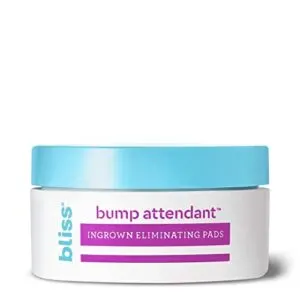
Featuring dual-action exfoliation through glycolic and salicylic acids, these convenient pads tackle ingrown hairs at their source.
You’ll find witch hazel and lavender oil soothing irritation while the acids dissolve dead skin cells blocking hair follicles.
Studies show 90% of users achieved bump-free skin within ten days of daily use.
Apply these dermatologist-tested pads 24 hours after hair removal on clean, dry skin. They’re effective across multiple body areas and safe for sensitive skin, though you’ll want sunscreen since AHAs increase photosensitivity.
Best For: Those seeking quick, gentle relief from ingrown hairs, razor bumps, and rough skin across multiple body areas, especially after hair removal.
- Dual acids exfoliate and clear pores, reducing ingrown hairs and bumps.
- Soothing botanicals minimize irritation, making it safe for sensitive skin.
- Fast visible results, with most users seeing smoother skin in 10 days.
- Can’t be used immediately after shaving or waxing due to risk of irritation.
- May cause mild itching or stinging in those with extremely sensitive skin.
- Packaging sometimes prone to leakage or drying out.
2. Natural Body Exfoliation Skin Brush
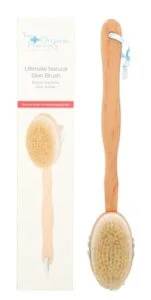
With ancient beauty rituals as your foundation, dry brushing transforms your skincare routine into something powerful.
Transform your skin from rough to radiant with the ancient power of dry brushing.
These natural bristle brushes physically remove dead skin cells that trap hairs beneath the surface, creating the perfect storm for ingrown bumps.
The stiff plant-based fibers work like tiny warriors, unclogging pores and lifting trapped hairs so they can grow outward freely.
Use gentle circular motions moving toward your heart—this isn’t about scrubbing hard, it’s about consistent technique that gives you smooth, bump-free skin.
Best For: Anyone seeking gentle, natural exfoliation to improve skin texture, boost circulation, and prevent ingrown hairs, especially those new to dry brushing or looking for a science-backed wellness option.
- Some users report issues with handle durability and an unusual odor upon opening.
- Requires regular maintenance to keep the brush clean and the handle secure.
- Can be too firm or abrasive for very sensitive or inflamed skin.
- Effectively removes dead skin and helps prevent ingrown hairs for smoother, softer skin.
- Natural Tampico fiber bristles and an ergonomic, detachable handle make it easy to use and reach all areas.
- Made in small batches with ethically sourced ingredients for higher quality and sustainability.
3. Natural Bristle Body Care Brush

Natural bristle brushes offer excellent exfoliation for preventing ingrown hairs.
These affordable tools effectively remove dead skin cells that trap hair beneath the surface, keeping follicles clear and promoting healthy hair growth.
Use gentle circular motions or long strokes toward your heart 2-3 times weekly.
The natural bristles stimulate blood circulation while unclogging pores, making this a spa-quality treatment at home.
Perfect for legs, underarms, and other ingrown-prone areas.
Best For: Anyone looking for an affordable, effective way to exfoliate, prevent ingrown hairs, and boost skin health at home.
- Inexpensive and easy to use, ideal for daily skincare routines.
- Gently removes dead skin and improves circulation for smoother, glowing skin.
- Supports eczema management and helps prevent ingrown hairs.
- Bristles may be too harsh for facial use or sensitive skin areas.
- Durability can vary, with bristle loss and strap odor over time.
- Thin handle and oval shape may be hard to grip, especially when wet.
4. Korean Exfoliating Mitt Bath Set
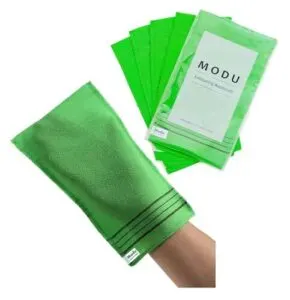
Korean exfoliating mitts offer a game-changing approach to tackling ingrown hairs through deep physical exfoliation.
Made from viscose or rayon, these textured mitts effectively remove dead skin cells that trap hairs beneath the surface.
You’ll need to soak in warm water for 10-15 minutes before use, then scrub in circular motions without soap.
The mitt visibly rolls off dead skin, unclogging pores and freeing trapped hairs, providing ideal results with regular use, which should be done 2-4 times monthly.
Best For: Anyone seeking affordable, at-home spa-quality exfoliation to smooth rough skin, prevent ingrown hairs, and improve overall skin texture, especially on areas prone to bumps.
- Delivers deep, visible exfoliation rivaling professional spa treatments
- Economical, reusable, and eco-friendly compared to disposable scrubs
- Provides smoother, clearer skin and helps prevent ingrown hairs
- Shrinks after first use and may not fit all hand sizes comfortably
- Not suitable for sensitive areas like the face or for those with skin conditions (eczema, rosacea)
- Requires diligent cleaning of your tub or shower after use due to dead skin buildup
5. Dead Sea Salt Body Scrub
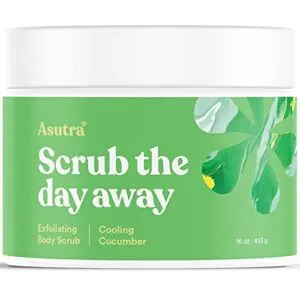
When you need a deep-clean exfoliant that won’t irritate sensitive skin, Dead Sea salt body scrub delivers natural mineral power.
Packed with over 20 healing minerals, it gently removes dead skin cells that trap hairs beneath the surface.
The magnesium-rich formula hydrates while exfoliating, reducing inflammation and preventing those pesky bumps.
You’ll get anti-inflammatory benefits plus improved circulation—perfect for bikini lines and other trouble spots prone to ingrown hairs.
Best For: Anyone with dry, sensitive, or problem-prone skin looking for a gentle, all-natural exfoliant that hydrates, soothes, and prevents ingrown hairs.
- Gently exfoliates and moisturizes without irritation, suitable even for sensitive skin.
- Rich in minerals and essential oils that hydrate, heal, and improve skin texture.
- Vegan, cruelty-free formula with clean, sustainably sourced ingredients.
- Grainy texture may be too abrasive for some users if not applied gently.
- Oil content can be messy or leave a residue in the shower.
- Scent and consistency may vary due to natural ingredients and recent packaging changes.
6. Keratosis Pilaris Body Scrub Exfoliator
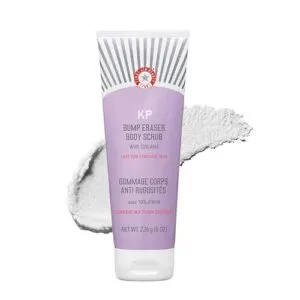
When keratosis pilaris clogs your hair follicles, you’re basically dealing with a double whammy of bumpy skin and increased ingrown hair risk.
First Aid Beauty’s KP Body Scrub tackles both problems with its dual-action formula combining 10% glycolic and lactic acids with pumice buffing beads.
This dermatologist-tested scrub doesn’t just smooth rough "chicken skin" – it actively prevents hairs from getting trapped beneath dead skin buildup, resulting in noticeably softer skin after your first treatment, and should be used 2-3 times weekly for optimal results with dual-action formula.
Best For: Anyone struggling with keratosis pilaris, rough or bumpy skin, and people prone to ingrown hairs who want fast, visible results and gentle exfoliation.
- Combines both chemical (AHAs) and physical exfoliation for quick, noticeable smoothing.
- Dermatologist-tested, vegan, and free from common irritants; suitable for sensitive skin.
- Pleasant, peach-scented formula that rinses clean and leaves skin softer after just one use.
- Can increase sun sensitivity, making sunscreen a must after use.
- Not a permanent cure for KP; requires consistent, ongoing use.
- Higher price point compared to some other body scrubs, though a little goes a long way.
7. CeraVe Daily Moisturizing Body Lotion
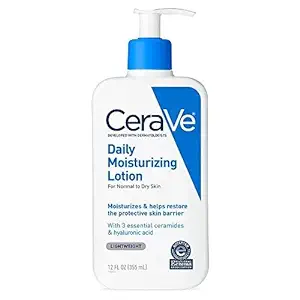
While exfoliation removes dead skin cells, proper moisturization completes your ingrown hair prevention strategy.
CeraVe’s Daily Moisturizing Body Lotion contains three essential ceramides and hyaluronic acid that restore your skin’s natural barrier.
This dermatologist-developed formula keeps skin hydrated for 24 hours, preventing the dryness that traps hairs beneath the surface.
The lightweight, non-comedogenic lotion absorbs quickly without clogging pores, making it perfect for post-shaving care when your skin needs gentle hydration most.
Best For: Anyone with dry, sensitive, or eczema-prone skin looking for gentle, all-day hydration and support for the skin barrier, especially after shaving or exfoliation.
- Long-lasting hydration with lightweight, non-greasy feel
- Dermatologist-recommended, safe for sensitive and acne-prone skin
- Fragrance-free and non-comedogenic, minimizing irritation and breakouts
- Does not provide sun protection (no SPF included)
- May feel too light for those needing extra-rich moisture in winter
- Some users notice a mild commercial lotion scent despite being fragrance-free
8. Hydrating Body Lotion For Dry Skin
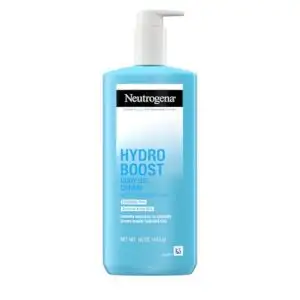
Nobody wants to deal with stubborn ingrown hairs that keep coming back.
Neutrogena’s Hydro Boost Body Gel Cream breaks this cycle with hyaluronic acid that holds 1,000 times its weight in water.
This fragrance-free formula hydrates deeply while maintaining your skin’s moisture barrier—the key to preventing those pesky bumps.
Many dermatologists suggest moisturizers with ceramides for skin to strengthen this barrier.
Users report smoother skin texture and fewer razor bumps within weeks.
The lightweight, non-greasy texture absorbs quickly, making daily application effortless for long-term ingrown hair prevention.
Best For: People with dry, sensitive skin who want a lightweight, fragrance-free moisturizer to prevent ingrown hairs and improve skin texture.
- Deeply hydrates with hyaluronic acid and maintains the moisture barrier
- Lightweight, fast-absorbing, and non-greasy for daily use
- Fragrance-free and suitable for sensitive or easily irritated skin
- May be less moisturizing than heavier creams for very dry skin
- Pump dispenser can have issues with consistent use
- Some users report a slight sticky feeling after application
9. Cortizone Maximum Strength Itch Cream
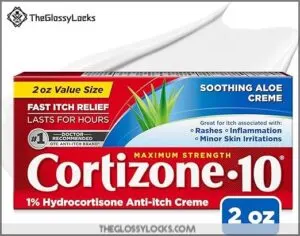
After dealing with those pesky ingrown hair bumps, you’ll want relief from the itching and inflammation.
Cortizone Maximum Strength contains 1% hydrocortisone—the strongest anti-itch formula you can buy without a prescription.
This fragrance-free cream works within 10 minutes, calming irritated skin after exfoliation.
Apply it sparingly to affected areas up to four times daily.
The aloe-enriched formula soothes without stinging, making it perfect for sensitive post-exfoliation skin recovery, providing relief from the itching.
Best For: Anyone looking for quick, non-irritating relief from itching and inflammation caused by ingrown hairs, eczema, bug bites, or other minor skin irritations.
- Fast-acting itch relief in under 10 minutes.
- Gentle, fragrance-free formula with soothing aloe.
- Portable size, recommended by dermatologists.
- May cause burning or bleaching if overused.
- Can be too harsh for very sensitive or severely inflamed skin.
- Requires reapplication every few hours for ongoing relief.
Ingrown Hair Prevention
Prevention starts with simple habit changes that reduce friction and irritation around hair follicles.
You’ll see fewer ingrown hairs when you wear loose clothing, skip solid antiperspirants, shave with the grain, and exfoliate regularly to keep dead skin cells from trapping new hair growth.
This can be achieved by following the instructions to reduce ingrown hairs, such as shaving with the grain and exfoliate regularly.
Wearing Loose-Fitting Clothing
Tight clothing creates constant friction against your skin, which can push hair back into follicles and worsen ingrown hair problems.
Choose loose-fitting garments that allow proper airflow around areas prone to ingrown hairs. Your fabric choice matters too—cotton and other breathable materials reduce friction better than synthetic fabrics.
This simple switch in your wardrobe can substantially improve comfort and prevent irritation while supporting your overall ingrown hair treatment routine.
Consider that hair removal methods can increase the risk of ingrown hairs, and it is essential to be aware of this risk to take preventive measures for ingrown hairs.
Avoiding Solid Antiperspirants
Solid antiperspirants contain pore-clogging ingredients that block sweat gland function and trap bacteria near hair follicles.
This creates perfect conditions for skin irritation and ingrown hairs after hair removal techniques like shaving or waxing.
Switch to antiperspirant alternatives like roll-on or spray formulas that won’t interfere with your skin care routine or exfoliation efforts.
Shaving Gently
Shaving gently transforms your hair removal routine from a potential irritation trigger into a smooth experience.
Sharp blades require less pressure, reducing trauma that forces hair back into follicles.
Prepare skin with warm water, shave with the grain, and avoid pulling skin taut.
This technique prevents the sharp edges that pierce skin and create ingrown hairs.
Exfoliating Regularly
Regular exfoliation becomes your secret weapon against stubborn ingrown hairs.
Most people benefit from exfoliating 2-3 times weekly, but you’ll need to adjust based on your skin’s sensitivity.
Chemical exfoliants penetrate deeper than physical exfoliation methods. Many users find relief using an ingrown hair scrub.
- Exfoliation frequency: Start with twice weekly, then adjust based on your skin’s response and tolerance levels
- Chemical exfoliants: Use salicylic or glycolic acid products that dissolve dead skin buildup around follicles effectively
- Post-exfoliation care: Always moisturize after using exfoliation tools to maintain your skin’s protective barrier and prevent irritation
Ingrown Hair Treatment
When you’re dealing with existing ingrown hairs, treatment focuses on reducing inflammation and encouraging the trapped hair to surface naturally.
The key is gentle care that soothes irritated skin while preventing infection or scarring, which is crucial for reducing inflammation.
Applying Cold Compresses
Cold compresses offer immediate relief when ingrown hairs become your skin’s unwelcome guests.
Apply ice wrapped in a thin cloth for 10-15 minutes to reduce inflammation and numb discomfort.
This simple remedy helps calm angry follicles while you plan your next exfoliation strategy.
| Compress Method | Benefits |
|---|---|
| Ice cubes in cloth | Reduces inflammation quickly |
| Frozen gel pack | Provides consistent cold temperature |
| Cold wet towel | Gentle option for sensitive skin |
| Chilled spoon | Targets small specific areas |
| Ice water compress | Easy DIY pain relief solution |
Using Hydrocortisone Cream
Hydrocortisone cream offers targeted relief for skin inflammation caused by ingrown hairs.
This topical corticosteroid reduces swelling and itching by suppressing inflammatory chemicals in your skin.
Proper hydrocortisone application involves:
- Apply thin layer following hair growth direction
- Use sparingly once or twice daily after shaving
- Limit duration to one week maximum without medical advice
- Wash hands before and after application to prevent contamination
- Avoid broken skin and space applications 10 minutes apart from other products
While hydrocortisone benefits include quick symptom relief, be mindful of side effects from long-term use like skin thinning.
For persistent ingrown hair solutions requiring extended treatment, consult healthcare providers about alternative treatments to safely exfoliate skin and manage ongoing inflammation.
Trying Warm Compresses
Heat therapy works wonders for stubborn ingrown hairs.
Apply warm compresses for 10-15 minutes, 2-3 times daily using clean washcloths soaked in warm water. This compress temperature should feel comfortably warm, not scalding.
The compress duration helps soften skin and reduce inflammation, encouraging trapped hairs to surface naturally.
Consider warm compress alternatives like warm tea bags for added anti-inflammatory benefits when traditional compress materials aren’t available, and apply them as you would a traditional compress.
Keeping The Area Clean and Moisturized
Maintaining proper hygiene forms the cornerstone of effective ingrown hair remedies.
Gentle cleansing with antibacterial soap prevents infection while removing debris that clogs follicles.
Post-cleanse care involves applying lightweight moisturizers to maintain skin hydration importance without blocking pores.
Your skin care routine should include fragrance-free products that support natural healing.
Consistent skin moisturization creates an ideal environment for trapped hairs to surface naturally through regular exfoliation and helps in natural healing.
Effective Exfoliation Methods
You don’t need to overthink exfoliation when dealing with ingrown hairs—the right method can make all the difference between smooth skin and persistent bumps.
Choose from acid-based treatments, dry brushing, or physical scrubs, but remember that consistency matters more than intensity.
Acid-Based Exfoliation
Acid-based chemical exfoliators like glycolic acid, salicylic acid, and lactic acid dissolve dead skin cells blocking follicles.
These beta hydroxy acids penetrate deeper than physical scrubs, making product selection vital for skin sensitivity.
For those seeking solutions, glycolic acid products may offer relief.
Start with lower acid concentration and monitor pH levels carefully, as chemical peels work gradually—think slow and steady wins the race.
Always patch-test first.
Dry-Brushing
Dry-brushing offers a physical exfoliation method that helps prevent ingrown hairs by lifting trapped hairs and removing dead skin cells.
This technique uses natural bristle brushes to stimulate circulation and promote lymphatic drainage while smoothing your skin’s surface.
- Brush Types: Choose natural bristle brushes with firm but not harsh bristles for effective skin exfoliation methods
- Dry-brushing Technique: Use upward strokes toward your heart, applying moderate pressure without irritating sensitive areas
- Skin Sensitivity: Test on a small area first, as some people experience irritation from this drybrushing method
- Circulation Benefits: Regular brushing improves blood flow, supporting healthier hair follicle function and reducing ingrown hairs
- Lymphatic Drainage: Gentle brushing movements help move lymphatic fluid, reducing inflammation around affected follicles
Using Scrubs With Sugar or Salt
Sugar and salt scrubs pack a powerful one-two punch against stubborn ingrown hairs. DIY Sugar Scrubs dissolve naturally while buffing away dead skin cells, making them perfect for Sensitive Skin Scrubs.
Many people enjoy using a pre-made sugar scrub for convenience.
Apply with gentle circular motions, focusing on problem zones. Store homemade scrubs in airtight containers for freshness, and consider the Salt Scrub Benefits which include deeper exfoliation for tougher areas, making DIY Sugar Scrubs a great option.
Limiting Exfoliation Frequency
Exfoliation frequency matters more than you think.
Over-exfoliation risks include increased skin sensitivity and irritation, potentially worsening ingrown hairs.
Follow a consistent exfoliation schedule based on your individual tolerance and product strength.
Most people benefit from exfoliating 2-3 times weekly, but sensitive skin may require less frequent skin exfoliation frequency to prevent overexfoliation.
Frequently Asked Questions (FAQs)
What helps draw out an ingrown hair?
Warm compresses applied 2-3 times daily help coax ingrown hairs to the surface by softening skin. You can also gently exfoliate with salicylic or glycolic acid to clear trapped follicles.
How to draw out an ingrown hair cyst?
Like a prisoner breaking free from chains, an ingrown hair cyst needs gentle coaxing to surface.
Apply warm compresses twice daily to soften skin and reduce inflammation.
Don’t squeeze or pick—let the hair emerge naturally to avoid scarring.
Does hydrogen peroxide get rid of ingrown hairs?
Hydrogen peroxide doesn’t directly eliminate ingrown hairs, but it can help prevent infection by cleaning the area.
It won’t coax trapped hairs out or address the root cause like proper exfoliation would.
How often should you replace exfoliating tools?
Studies show 80% of razor bumps stem from dull exfoliating tools harboring bacteria.
You’ll want to replace loofahs every 3-4 weeks, exfoliating gloves monthly, and pumice stones when they become smooth.
Fresh tools prevent infection and maintain effectiveness for ingrown hair prevention.
Can ingrown hairs cause permanent scarring?
Yes, ingrown hairs can cause permanent scarring, especially if you pick at them or they become infected.
Darker skin tones are particularly prone to hyperpigmentation and scarring from inflammation, so gentle treatment is essential.
Which body areas need different exfoliation techniques?
Your face needs gentler chemical exfoliants like lactic acid, while your bikini area requires physical scrubs with sugar.
Legs can handle stronger glycolic acid treatments, and underarms respond well to dry-brushing weekly.
Are electric razors better for preventing ingrowns?
Like choosing between a sword and a feather to cut through thorns, electric razors offer gentler passage through your skin’s landscape.
They’re substantially better than traditional blades for preventing ingrowns because they don’t cut hair as close to the follicle, reducing sharp edges that pierce skin.
When should you see a dermatologist?
You should see a dermatologist when ingrown hairs become infected, showing signs like pus, increasing pain, warmth, or spreading redness, or when they’re deeply embedded and won’t resolve naturally.
Conclusion
Consistently applying these ingrown hair exfoliating tips transforms your skin care routine from reactive to proactive.
Whether you choose chemical exfoliants, physical scrubs, or dry brushing, the key lies in gentle persistence rather than aggressive treatment.
Remember that prevention trumps cure every time.
Your skin responds best to regular, moderate exfoliation combined with proper moisturizing and loose-fitting clothing.
These evidence-based methods work when you commit to the process and listen to your skin’s needs.
- https://evolvemedspa.com/blog/dealing-with-ingrown-hairs-causes-and-effective-treatment-options/
- https://ucfhealth.com/health-tips/expert-advice-ingrown-hairs/
- https://www.skincare.com/body-care/hair-removal/how-to-get-rid-of-ingrown-hairs
- https://bushbalm.ca/blogs/how-to-guides/ingrown-hair-exfoliating-scrubs
- http://nymag.com/strategist/article/the-best-tools-to-battle-ingrowns.html

